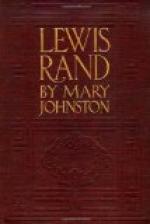The day was hot, but the chestnut trees and sycamores gave a grateful shade, and large white clouds in a brilliant blue threw now and then a transient screen between sun and earth. The broad and murmuring river and the far stretch of woodland upon the Chesterfield side gave, too, a sensation of space and coolness. Faint airs carried the smell of midsummer flowers, and bees droned around the flat tombstones sunk in honeysuckle. The congregation gathered slowly, the masculine portion of it lingering, as was the custom, in the wide old churchyard until the second tinkling of the bell should call them indoors. They had thus the double advantage of talk and observation of the Progress of Women. These traversed the path to the church door like a drift of blossoms in the summer air, saluted on either hand by the lowest of bows, the most gallant lifting of bell-shaped hats. Whatever might be said of the men’s dress, from the fair top-boot to the yards of lawn that swathed the throat, that of the weaker sex, in the days of the Empire, was admirably fitted for August weather. Above pale, thin stuffs, girdled beneath the breast and falling straight and narrow to the instep, rose bare white neck and arms, while each charming face looked forth from an umbrageous bonnet of fine straw. Bonnet and large fan appeared the only ample articles of attire; even the gloves were but mitts. By ones and twos, or in larger knots, the wearers of this slender finery entered Saint John’s with sedateness, took their seats in the dim old pews, and waited in the warm, fragrant, whisper-filled air for the ringing of the second bell and the entrance of the men. After church, custom would still reign, and all alike would linger, laugh, and talk beneath the trees, while the coaches drew up slowly and the grooms brought the saddle-horses from the rack, and those who meant to walk gathered courage for the dusty venture.




